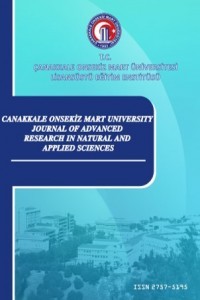Synthesis and Characterization of Cross-linkable Viologen Derivatives
Synthesis and Characterization of Cross-linkable Viologen Derivatives
Cross-linked film, DFT, surface morphology thiol-ene click chemistry, viologen,
___
- Altınışık, S., & Koyuncu, S. (2023). A Novel Viologen-Derived Covalent Organic Framework Based Metal Free Catalyst for Nitrophenol Reduction. ChemCatChem, 15(4), e202201418. https://doi.org/https://doi.org/10.1002/cctc.202201418
- Bange, K. (1999). Colouration of tungsten oxide films: A model for optically active coatings. Solar Energy Materials and Solar Cells, 58(1), 1. https://doi.org/10.1016/S0927-0248(98)00196-2
- Bronstein, H., Nielsen, C. B., Schroeder, B. C., & McCulloch, I. (2020). The role of chemical design in the performance of organic semiconductors. Nature Reviews Chemistry, 4(2), 66-77. https://doi.org/10.1038/s41570-019-0152-9
- Ding, J., Zheng, C., Wang, L., Lu, C., Zhang, B., Chen, Y., Li, M., Zhai, G., & Zhuang, X. (2019). Viologen-inspired functional materials: synthetic strategies and applications [10.1039/C9TA01724K]. Journal of Materials Chemistry A, 7(41), 23337-23360. https://doi.org/10.1039/C9TA01724K
- Doyranlı, C., Altınışık, S., Özdemir, M., & Koyuncu, S. (2022). Tetra-Carbazole based electroactive donor-acceptor dyes: Effect of the phenyl bridging unit on the electrochromic performance. Dyes and Pigments, 204, 110467. https://doi.org/https://doi.org/10.1016/j.dyepig.2022.110467
- Gu, C., Jia, A.-B., Zhang, Y.-M., & Zhang, S. X.-A. (2022). Emerging Electrochromic Materials and Devices for Future Displays. Chemical Reviews, 122(18), 14679-14721. https://doi.org/10.1021/acs.chemrev.1c01055 Hoyle, C. E., & Bowman, C. N. J. A. C. I. E. (2010). Thiol–ene click chemistry. 49(9), 1540-1573. https://doi.org/10.1002/anie.200903924
- Killops, K. L., Campos, L. M., & Hawker, C. J. J. J. o. t. A. C. S. (2008). Robust, efficient, and orthogonal synthesis of dendrimers via thiol-ene “click” chemistry. 130(15), 5062-5064. https://doi.org/10.1021/ja8006325
- Kim, Y. J., Jeong, H. K., Seo, J. K., Chai, S. Y., Kim, Y. S., Lim, G. I., Cho, M. H., Lee, I. M., Choi, Y. S., & Lee, W. I. (2007). Effect of TiO2 particle size on the performance of viologen-anchored TiO2 electrochromic device. J Nanosci Nanotechnol, 7(11), 4106-4110. https://doi.org/https://doi.org/10.1166/jnn.2007.029
- Liu, Y., & Boyer, C. (2017). Thiol-ene click chemistry: a multifaceted toolbox for small molecule and polymer synthesis. Chemical Society Reviews, 46(14), 4174-4187. https://doi.org/10.1039/B901979K
- Lowe, A. B., Hoyle, C. E., & Bowman, C. N. J. J. o. M. C. (2010). Thiol-yne click chemistry: A powerful and versatile methodology for materials synthesis. 20(23), 4745-4750. https://doi.org/10.1039/B917102A
- Madasamy, K., Velayutham, D., Suryanarayanan, V., Kathiresan, M., & Ho, K.-C. (2019). Viologen-based electrochromic materials and devices [10.1039/C9TC00416E]. Journal of Materials Chemistry C, 7(16), 4622-4637. https://doi.org/10.1039/C9TC00416E
- Moon, H. C., Lodge, T. P., & Frisbie, C. D. (2014). Solution-Processable Electrochemiluminescent Ion Gels for Flexible, Low-Voltage, Emissive Displays on Plastic. Journal of the American Chemical Society, 136(9), 3705-3712. https://doi.org/10.1021/ja5002899
- Oh, H., Seo, D. G., Yun, T. Y., Kim, C. Y., & Moon, H. C. (2017). Voltage-Tunable Multicolor, Sub-1.5 V, Flexible Electrochromic Devices Based on Ion Gels. ACS Appl Mater Interfaces, 9(8), 7658-7665. https://doi.org/10.1021/acsami.7b00624
- Shah, K. W., Wang, S.-X., Soo, D. X. Y., & Xu, J. (2019). Viologen-Based Electrochromic Materials: From Small Molecules, Polymers and Composites to Their Applications. Polymers, 11(11), 1839. https://www.mdpi.com/2073-4360/11/11/1839
- Striepe, L., & Baumgartner, T. (2017). Viologens and Their Application as Functional Materials. Chemistry – A European Journal, 23(67), 16924-16940. https://doi.org/https://doi.org/10.1002/chem.201703348
- Vinh Quy, V. H., Kim, K.-W., Yeo, J., Tang, X., In, Y. R., Jung, C., Oh, S. M., Kim, S. J., Lee, S. W., Moon, H. C., & Kim, S. H. (2022). Tunable electrochromic behavior of biphenyl poly(viologen)-based ion gels in all-in-one devices. Organic Electronics, 100, 106395. https://doi.org/https://doi.org/10.1016/j.orgel.2021.106395
- Wang, H., Barrett, M., Duane, B., Gu, J., & Zenhausern, F. (2018). Materials and processing of polymer-based electrochromic devices. Materials Science and Engineering: B, 228, 167-174. https://doi.org/https://doi.org/10.1016/j.mseb.2017.11.016
- Yayın Aralığı: Yılda 4 Sayı
- Başlangıç: 2015
- Yayıncı: Çanakkale Onsekiz Mart Üniversitesi
Küçükçekmece Lagünü'nün Çevre Manyetizması: Son 3900 yıl boyunca paleo-ortam değişimleri
Laurencia obtusa (Hudson) J.V. Lamouroux, 1813’nın Besin İçeriğindeki Mevsimsel Değişimler
Melek ERSOY KARAÇUHA, Gökhan YILDIZ, Ali KARAÇUHA
Effect of Atypical Antipsychotic Usage at Therapeutic Doses on Daytime Sleepiness
Meltem ALAN, Tuğba Nurcan YÜKSEL, Birol TOPCU
Improving End-Point Position Control in Hydraulic Testing Machines with a Fuzzy Logic Based Approach
Domates (Solanum lycopersicum L.)’te Fungisit Stresine Karşı Kitosanın Etkisi
Hüseyin BULUT, Halil İbrahim ÖZTÜRK
A Living River” of Çanakkale Sarıçay Region Examination in the Scope
Merve TEMİZ TOPSAKAL, Alper SAĞLIK, Zekeriye GÖK
For Loan Processing a Fuzzy Process Mining
İbrahim Ethem YAZICI, Orhan ENGİN
A mobile application-based decision support system for routing and decision making problems
